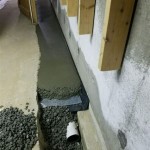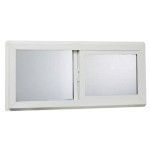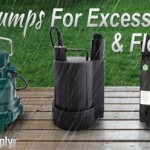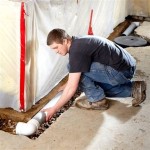How To Wash Cement Basement Floor
A cement basement floor, while durable, can accumulate dirt, dust, stains, and efflorescence over time. Regular cleaning is essential to maintain a healthy and aesthetically pleasing basement environment. This article provides a comprehensive guide on how to effectively wash a cement basement floor, covering preparation, cleaning methods, and preventative measures.
Preparation is Key to a Successful Cleaning
Before initiating the washing process, proper preparation is crucial to ensure efficiency and prevent potential damage. This involves removing obstacles, addressing potential hazards, and gathering the necessary cleaning supplies.
1. Clear the Area: The first step involves removing all items from the area to be cleaned. This includes furniture, boxes, stored items, and any other objects that may obstruct access to the entire floor surface. Lifting items entirely out of the basement is preferable, but if this is not possible, consolidate items in a single area and cover them with plastic sheeting to protect them from water and cleaning solutions. This allows for unobstructed cleaning and prevents moisture damage to belongings.
2. Sweep or Vacuum the Floor: Before introducing water, thoroughly sweep or vacuum the entire floor surface. This removes loose debris, dust, dirt, and cobwebs that would otherwise become muddy and harder to remove when wet. Use a broom with stiff bristles for sweeping, or a vacuum cleaner with a hard floor attachment. Pay particular attention to corners, edges, and cracks where debris tends to accumulate. Removing loose particles prior to washing significantly improves the effectiveness of the cleaning process.
3. Identify and Address Stains: Conduct a thorough inspection of the basement floor to identify any existing stains. Common basement floor stains include oil, grease, paint, rust, and mold. Addressing these stains before general washing is crucial, as the washing process may set some stains further, making them more difficult to remove later. Different types of stains require specific cleaning solutions and techniques. For instance, oil and grease stains often respond well to degreasers, while rust stains may require specialized rust removers. Mold stains should be treated with appropriate anti-mold solutions.
4. Gather Cleaning Supplies: Assemble all the necessary cleaning supplies before beginning the washing process. This will streamline the cleaning procedure and prevent unnecessary delays. Essential supplies include:
- Bucket or large container
- Mop (either a string mop or a flat mop with microfiber pads)
- Scrub brush with stiff bristles
- Cleaning solution (appropriate for cement floors)
- Rubber gloves
- Eye protection (goggles or safety glasses)
- Knee pads (optional, but recommended for extended scrubbing)
- Clean water source
- Wet/dry vacuum (optional, but useful for removing excess water)
5. Ensure Adequate Ventilation: Basement environments can often be poorly ventilated, particularly when cleaning solutions are used. Open windows and doors to provide adequate ventilation and prevent the build-up of fumes. If natural ventilation is limited, consider using a fan to circulate air and improve ventilation. This is particularly important when using stronger cleaning solutions.
Choosing the Right Cleaning Method and Solution
The appropriate cleaning method and solution will depend on the condition of the floor and the type of stains present. A variety of options are available, ranging from simple soap and water to more specialized cleaning agents.
1. Mild Cleaning with Soap and Water: For lightly soiled floors, a simple solution of soap and water may suffice. Use a mild, pH-neutral soap, such as dish soap or a specialized floor cleaner designed for cement. Mix the soap with warm water according to the manufacturer's instructions. Avoid using excessive soap, as it can leave a residue on the floor. This method is suitable for routine cleaning and maintenance to remove surface dirt and dust.
2. Using Trisodium Phosphate (TSP): For more heavily soiled floors, trisodium phosphate (TSP) can be used. TSP is a strong cleaning agent that is effective at removing grease, grime, and dirt. However, it is a harsh chemical and should be used with caution. Always wear rubber gloves and eye protection when handling TSP. Mix TSP with water according to the manufacturer's instructions. Apply the solution to the floor, scrub with a brush, and rinse thoroughly with clean water. Due to its environmental impact, TSP is restricted or banned in some areas, so check local regulations before using it. Alternatives such as TSP substitutes are available.
3. Utilizing a Degreaser for Oil and Grease Stains: Oil and grease stains are common in basements, particularly in areas where cars are parked or machinery is stored. To remove these stains, use a specialized degreaser designed for concrete floors. Apply the degreaser directly to the stain, following the manufacturer's instructions. Allow the degreaser to sit for the recommended time, then scrub with a brush and rinse thoroughly with clean water. Multiple applications may be necessary for stubborn stains.
4. Employing an Acidic Cleaner for Efflorescence: Efflorescence is a white, powdery deposit that can form on concrete floors due to the migration of salts to the surface. To remove efflorescence, use an acidic cleaner designed for concrete. Muriatic acid is a common choice, but it is a highly corrosive substance and should be used with extreme caution. Always wear rubber gloves, eye protection, and a respirator when handling muriatic acid. Dilute the acid with water according to the manufacturer's instructions, and apply it to the efflorescence. Allow it to sit for a few minutes, then scrub with a brush and rinse thoroughly with clean water. Ensure adequate ventilation when using muriatic acid. Consider using a less aggressive acidic cleaner, such as vinegar diluted with water, for milder cases of efflorescence.
5. Pressure Washing (Outdoor Access): If the basement has outdoor access, a pressure washer can be an effective way to clean the floor. However, caution must be exercised to avoid damaging the concrete. Use a low-pressure setting and a wide-angle nozzle to prevent etching or pitting the surface. Ensure that the area is well-ventilated and that all electrical outlets and equipment are protected from water. Pressure washing is particularly effective for removing large amounts of dirt, grime, and mold. Always test a small, inconspicuous area first to ensure that the pressure washer does not damage the concrete.
The Washing Process and Post-Cleaning Procedures
After the preparation and solution selection, the washing process itself requires a systematic approach to ensure thorough cleaning and prevent the spread of dirt. Post-cleaning procedures are equally important to ensure the floor dries properly and to protect it from future staining.
1. Applying the Cleaning Solution: Once the appropriate cleaning solution has been selected and prepared, apply it evenly to the floor surface. If using a mop, dip the mop into the solution and wring out the excess water. Work in small sections, applying the solution liberally to the floor. If using a spray bottle, spray the solution evenly over the floor surface. Avoid applying too much solution, as this can make it difficult to rinse the floor thoroughly.
2. Scrubbing the Floor: After applying the cleaning solution, scrub the floor thoroughly with a scrub brush. Use firm, even strokes to remove dirt, grime, and stains. Pay particular attention to areas with heavy soiling or stains. For stubborn stains, allow the cleaning solution to sit on the stain for a few minutes before scrubbing. Work in small sections, overlapping each section to ensure complete coverage. If using a powered floor scrubber, follow the manufacturer's instructions carefully.
3. Rinsing the Floor: After scrubbing the floor, rinse it thoroughly with clean water. Use a mop or a wet/dry vacuum to remove the dirty water. Change the water frequently to ensure that the floor is rinsed completely. Any remaining cleaning solution can leave a residue on the floor, which can attract dirt and grime. Multiple rinses may be necessary to remove all traces of the cleaning solution. Ensure that all corners and edges are thoroughly rinsed.
4. Drying the Floor: After rinsing the floor, allow it to dry completely. Open windows and doors to provide adequate ventilation. Use fans to circulate air and speed up the drying process. A wet/dry vacuum can be used to remove excess water and expedite drying. Avoid walking on the floor until it is completely dry. A damp floor can attract dirt and grime. The drying time will depend on the humidity and temperature. In humid environments, it may take several hours or even overnight for the floor to dry completely.
5. Sealing the Floor (Optional): After the floor is completely dry, consider applying a concrete sealer. A concrete sealer will protect the floor from stains, water damage, and efflorescence. It will also make the floor easier to clean in the future. Choose a sealer that is specifically designed for concrete floors. Follow the manufacturer's instructions carefully when applying the sealer. Ensure that the floor is completely dry before applying the sealer. Multiple coats of sealer may be necessary for optimal protection.
6. Preventative Measures: To minimize the need for frequent and intensive cleaning, implementing preventative measures is essential. These measures help to maintain the cleanliness of the basement floor and protect it from future damage.
One key measure is to use floor mats in high-traffic areas, such as entryways and areas near stairs. These mats trap dirt and debris, preventing them from being tracked onto the main floor surface. Regular cleaning of these mats is essential to maintain their effectiveness.
Promptly cleaning up spills is another important preventative measure. Spills, especially those containing oil, grease, or chemicals, can stain the floor if left unattended. Wipe up spills immediately with a clean cloth or paper towel. For stubborn spills, use an appropriate cleaning solution to remove the stain.
Controlling humidity levels in the basement can also help to prevent the growth of mold and mildew. Use a dehumidifier to maintain a humidity level below 50%. Ensure that the basement is well-ventilated to prevent the build-up of moisture. Regularly inspect the basement for signs of leaks or water damage and address them promptly.
Regular sweeping or vacuuming of the floor is essential to remove loose dirt and debris. This prevents the accumulation of dirt and grime, which can make the floor more difficult to clean. Sweep or vacuum the floor at least once a week, or more frequently if needed.

How To Clean Cement Basement Floor Smartvacuumguide Com

How To Clean A Concrete Basement Floor 6 Diy Methods Prudent Reviews

Post Flood Cleanup How To Clean A Concrete Basement Floor Csg Renovation

Final Cleaning And Washing Of The Basement Floor Avoision Com

10 Amazing Tips To Clean A Concrete Basement Floor

Guide How To Clean Concrete Floor In Basement Alliance Flooring Directory

How To Clean Concrete Floors In The Basement Family Handyman

How To Clean Concrete Basement Floor Southern Illinois

6 Ways To Get Your Dirty Basement Floor Sparkling Clean Trusted Since 1922

How To Clean Seal Concrete Floors Youtube







